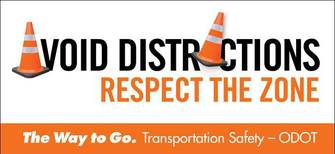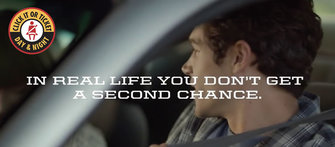|
May is Transportation Safety Month and Oregon's kick-off to the
work zone construction season.
Work zone safety is a top priority for ODOT, our industry partners and law enforcement. We
engineer, construct and enforce work zones to lower the risk to travelers and
workers.
Drivers traveling Oregon roads are asked to recognize the
importance of slowing down and drive with focus as they approach, enter and
travel through work zones, for their own safety and that of their passengers,
other drivers, construction and utility workers, and public safety professionals.
Orange is your clue to slow down.

With sunshine in the
forecast and summer around the corner, more and more motorcyclists will be
taking to Oregon’s winding roads. During Motorcycle Safety Awareness Month in
May - and during the rest of the year - drivers of all other vehicles and all
road users are reminded to safely "share the road" with
motorcyclists, and to be extra alert to help keep motorcyclists safe.
Rumble strips save lives,
and ODOT is getting the word out with a new video, social media posts and more. A rumble strip's sound and physical vibration warns inattentive drivers, allowing them to self-correct and avoid a crash.
Oregon has developed a program that assists drivers in overcoming
the obstacle of alcoholism to help reduce the number of repeat Driving while
Under the Influence of Intoxicants (DUII) offenders. DUII courts that are in
part funded through a grant from ODOT have proven successful by providing
resources to high risk drivers such as substance abuse treatment, regular court
appearances, random urinalysis, regular meetings with a caseworker, etc. Rather
than punishing impaired drivers with jail time, which offers very little
long-term recovery, the program focuses on reducing the chemical dependency.
The
results from a DUII-specific treatment court are very positive in terms of
recidivism. The B-SOBR approach is very
systemic, dealing with addiction, but also sober living, employment, education,
family support and relationships, volunteerism in the community, physical
health, mental health and accountability.
Learn more from a recent graduate. (Source: KOIN-TV)
Oregon State Police, sheriffs, and local police will be working to increase proper
safety belt and child car seat use during a statewide traffic enforcement
“blitz” on May 16-29. Officers will also be on the alert for
persons exceeding the posted speed limit or violating the “hands-free”
cellphone law.
Of all the occupant fatalities in 2015, 41 percent were unbelted
or of unknown restraint usage. Using your safety belt or child restraint
correctly greatly reduces your risk of a fatal injury. Buckle up. The Way to Go.

|